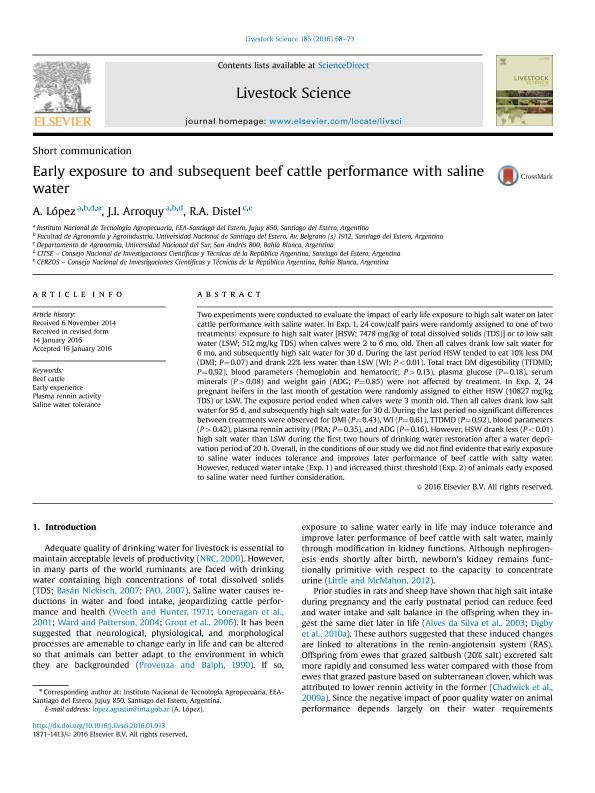Mostrar el registro sencillo del ítem
dc.contributor.author
Lopez, Agustin

dc.contributor.author
Arroquy, Jose Ignacio

dc.contributor.author
Distel, Roberto Alejandro

dc.date.available
2017-09-28T16:50:26Z
dc.date.issued
2016-03
dc.identifier.citation
Lopez, Agustin; Arroquy, Jose Ignacio; Distel, Roberto Alejandro; Early exposure to and subsequent beef cattle performance with saline water; Elsevier Science; Livestock Science; 185; 3-2016; 58-63
dc.identifier.issn
1871-1413
dc.identifier.uri
http://hdl.handle.net/11336/25302
dc.description.abstract
Two experiments were conducted to evaluate the impact of early life exposure to high salt water on later cattle performance with saline water. In Exp. 1, 24 cow/calf pairs were randomly assigned to one of two treatments: exposure to high salt water [HSW; 7478 mg/kg of total dissolved solids (TDS)] or to low salt water (LSW; 512 mg/kg TDS) when calves were 2 to 6 mo. old. Then all calves drank low salt water for 6 mo, and subsequently high salt water for 30 d. During the last period HSW tended to eat 10% less DM (DMI; P=0.07) and drank 22% less water than LSW (WI; P<0.01). Total tract DM digestibility (TTDMD; P=0.92), blood parameters (hemoglobin and hematocrit; P>0.13), plasma glucose (P=0.18), serum minerals (P>0.08) and weight gain (ADG; P=0.85) were not affected by treatment. In Exp. 2, 24 pregnant heifers in the last month of gestation were randomly assigned to either HSW (10827 mg/kg TDS) or LSW. The exposure period ended when calves were 3 month old. Then all calves drank low salt water for 95 d, and subsequently high salt water for 30 d. During the last period no significant differences between treatments were observed for DMI (P=0.43), WI (P=0.61), TTDMD (P=0.92), blood parameters (P>0.42), plasma rennin activity (PRA; P=0.35), and ADG (P=0.16). However, HSW drank less (P<0.01) high salt water than LSW during the first two hours of drinking water restoration after a water deprivation period of 20 h. Overall, in the conditions of our study we did not find evidence that early exposure to saline water induces tolerance and improves later performance of beef cattle with salty water. However, reduced water intake (Exp. 1) and increased thirst threshold (Exp. 2) of animals early exposed to saline water need further consideration.
dc.format
application/pdf
dc.language.iso
eng
dc.publisher
Elsevier Science

dc.rights
info:eu-repo/semantics/openAccess
dc.rights.uri
https://creativecommons.org/licenses/by-nc-sa/2.5/ar/
dc.subject
Beef Cattle
dc.subject
Early Experience
dc.subject
Plasma Rennin Activity
dc.subject
Saline Water Tolerance
dc.subject.classification
Otras Producción Animal y Lechería

dc.subject.classification
Producción Animal y Lechería

dc.subject.classification
CIENCIAS AGRÍCOLAS

dc.title
Early exposure to and subsequent beef cattle performance with saline water
dc.type
info:eu-repo/semantics/article
dc.type
info:ar-repo/semantics/artículo
dc.type
info:eu-repo/semantics/publishedVersion
dc.date.updated
2017-07-27T12:26:42Z
dc.journal.volume
185
dc.journal.pagination
58-63
dc.journal.pais
Países Bajos

dc.journal.ciudad
Amsterdam
dc.description.fil
Fil: Lopez, Agustin. Instituto Nacional de Tecnología Agropecuaria. Centro Regional Tucuman-santiago del Estero. Estación Experimental Agropecuaria Santiago del Estero; Argentina
dc.description.fil
Fil: Arroquy, Jose Ignacio. Instituto Nacional de Tecnología Agropecuaria. Centro Regional Tucuman-santiago del Estero. Campo Experimental Regional Leales; Argentina. Consejo Nacional de Investigaciones Científicas y Técnicas. Centro de Investigaciones y Transferencia de Santiago del Estero. Universidad Nacional de Santiago del Estero. Centro de Investigaciones y Transferencia de Santiago del Estero; Argentina
dc.description.fil
Fil: Distel, Roberto Alejandro. Consejo Nacional de Investigaciones Científicas y Técnicas. Centro Científico Tecnológico Conicet - Bahía Blanca. Centro de Recursos Naturales Renovables de la Zona Semiárida. Universidad Nacional del Sur. Centro de Recursos Naturales Renovables de la Zona Semiárida; Argentina
dc.journal.title
Livestock Science

dc.relation.alternativeid
info:eu-repo/semantics/altIdentifier/doi/http://dx.doi.org/10.1016/j.livsci.2016.01.013
dc.relation.alternativeid
info:eu-repo/semantics/altIdentifier/url/http://www.sciencedirect.com/science/article/pii/S1871141316300130
Archivos asociados
